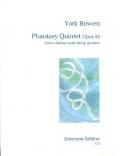Phantasy Quintet op. 93
Disclaimer
C.I.R.C.B. is not responsible for any material supplied by third parties. C.I.R.C.B. does not assume any legal liability for the consequences related to downloading material that is not in the public domain in your country. Always check before download, not to infringe copyright. Please respect the copyright laws of your country.
Title
Phantasy Quintet op. 93
Genre:
Classic
Repertoire:
with String Quartet
Composition Year:
1935
Recordings
| Track | Movement(s) | Duration | |
|---|---|---|---|
| 5. | 13:43 |
| Track | Movement(s) | Duration | |
|---|---|---|---|
| 11. | I. | Allegro moderato | 06:47 |
| 12. | II. | Allegro con spirito, non troppo | 02:55 |
| 13. | III. | Allegro moderatoma più tranquillo | 03:15 |
| Track | Movement(s) | Duration | |
|---|---|---|---|
| 22. | I. | Allegro moderato | 06:48 |
| 23. | II. | Allegro con spirito, non troppo | 02:55 |
| 24. | III. | Allegro moderato ma più tranquillo | 03:19 |
Original / Trascription:
Original
Instruments:
bass clarinet
string quartet
Publishing House
Emerson Edition
Catalog Number:
M100025881


Notes
York Bowen's Phantasy Quintet is the first chamber ensemble work to fully display all aspects of the bass clarinet's capabilities and characteristics. Composed in a style influenced by the English impressionist Delius and reminiscent of Debussy's string quartet, op. 10, its sweeping melodic lines, which vary from a darkly mysterious to a rich singing tone, require a great agility throughout a wide tessitura. Bowen (1884-1961) is remembered primarily as a composer for the piano, though he also composed a sonata for the clarinet and piano, dedicated to Pauline Juler, in 1943.1 It is possible, though not certain, that Juler was the first performer of the Phantasy Quintet, as well. Although the works was published around 1940 by the London firm De Wolfe, it did not remain in print long and has become difficult to obtain.2
A virtuosic lyricism is needed to produce a wide variety of moods; tranquilly pastoral, mysterious, impetuous, and fiery. The melodies frequently arch over a span of two and a half octaves. Motion in sixteenth and sixteenth-sextuplets is common throughout the instrument's range, which extends from E to g''. Although the lowest chalumeau tones predominate, all portions of this compass of three octaves and a minor third are used effectively. In the middle allegro con spirito section, the proportions of the range use are:
Great demands are not made on articulation, but legato in the sometimes long phrases is important. The requirements for delicate color shadings, ensemble blend, agility and intonation in frequently very high passages made of the string quartet are considerable.
The work is in one movement, 336 measures in length. Its A-B-A form has a tempo structure of allegro moderato (♩= 104) with several varied subsections, allegro con spirito (♩= 114), and return to the opening material in a slightly more relaxed tempo designated as "allegro moderato ma più tranquillo (♩= 80)." The tonal center is E, with shifting, though predominantly minor modality. The bass clarinet part uses French notation.
Phantasy Quintet was written sometime between 1933 and 1936, along with several other 'Phantasy' works by other composer, in response to a competition initiated by Walter Cobbett. An early recording of BBC Third Programme broadcast by Walter Lear (1894-1981), possibly the first performance, was found in the composer's collection. It is now in the Royal Academy of Music library in London.3
© Aber, "A history of the bass clarinet as an orchestra and solo instrument in the nineteenth and early twentieth centuries and an annotated, chronological list of solo repertoire for the bass clarinet from before 1945": 133-135
1 York Bowen, Sonata for Clarinet and Piano, (Amplesforth, Yorkshire: Emerson Editions, 1985).
2 The Catalogue of Printed Music in the British Library to 1980 7 (London: K. G. Saur, 1982), 287
3 Lines from the back cover of hte Phantasy Quintet by Emerson Edition 415